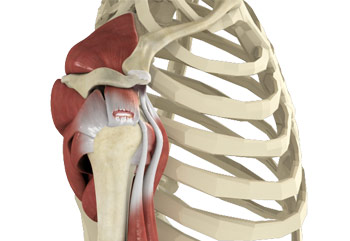Rotator Cuff Tear

Rotator cuff is the group of tendons in the shoulder joint providing support and enabling wider range of motion. Major injury to these tendons may result in tear of these tendons and the condition is called as rotator cuff tear. It is one of the most common causes of shoulder pain in middle aged adults and older individuals.
Causes
Rotator cuff tear results from pressure on the rotator cuff from part of the shoulder blade (scapula) as the arm is lifted. It may occur with repeated use of arm for overhead activities, while playing sports or during motor accidents.
Symptoms
Rotator cuff tear causes severe pain, weakness of the arm, and crackling sensation on moving shoulder in certain positions. There may be stiffness, swelling, loss of movements, and tenderness in the front of the shoulder.
Diagnosis
Your surgeon diagnoses Rotator Cuff Tear based on the physical examination, X-rays, and imaging studies, such as MRI. Rotator cuff tear is best viewed on magnetic resonance imaging.
Conservative Treatment Options
- Rest
- Shoulder sling
- Pain medication Injection of a steroid (cortisone) and a Local anaesthetic in the subacromial space of the affected shoulder to help decrease the inflammation and pain
- Certain Exercises
Surgery
Rotator cuff repair may be performed by open surgery or arthroscopic procedure. In arthroscopy procedure space for rotator cuff tendons will be increased and the cuff tear is repaired using suture anchors. These anchor sutures help in attaching the tendons to the shoulder bone. Following the surgery, you may be advised to practice motion and strengthening exercises.
Disclaimer: Following video links are for demonstration purposes and for understanding of the basic idea and concept of the procedure. The actual procedure may differ and may not be the same. This website does not take any responsibility for authenticity of videos.
Please go through the benefits, risks and rehabilitation of the procedure fully before consenting. Some of these are explained in shoulder surgery protocols under patient info tab.
A RAISED RISK OF ALL-CAUSE MORTALITY HAS BEEN SEEN IN A STUDY OF NEW USERS OF PRESCRIPTION OPIOIDS FOR NONCANCER PAIN.
The study of 1,066,216 UK, US and Canadian patients found a mortality risk six to 12 times higher for those on morphine compared with codeine.1
Strong opioids including morphine, fentanyl, buprenorphine, oxycodone, and combination opioids, and those on higher morphine doses, had a higher risk of all-cause mortality.This study found that the risks of serious harms increases on stronger opioids and especially for those people on doses of 50 or more morphine milligram equivalents per day.
In the UK, those given morphine had 12.6 times the likelihood of all-cause mortality than those given codeine.
In particular, the use of antipsychotics plus opioids was consistently associated with a higher risk of mortality in both the US and UK cohorts in this study
Meghnaa J, Nadyne G, et al. Comparative risk of mortality in new users of prescription opioids for noncancer pain: results from the International Pharmacosurveillance Study. Pain Online 2024 ():10.1097/j.pain.0000000000003446, October 29, 2024. | DOI: 10.1097/j.pain.0000000000003446
